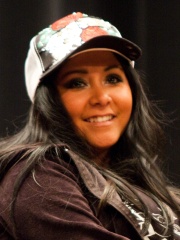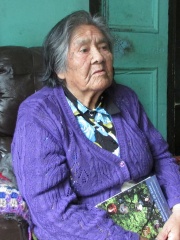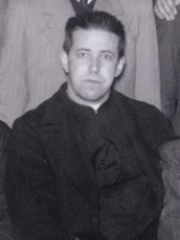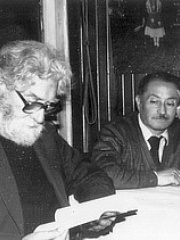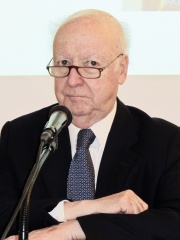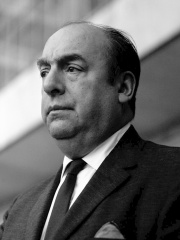
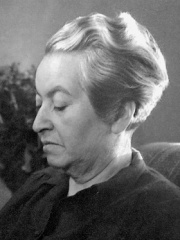
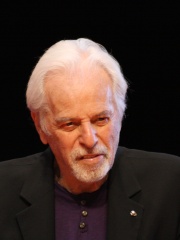
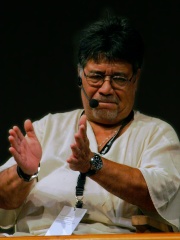
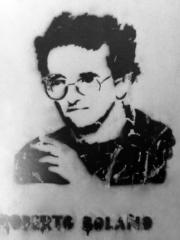
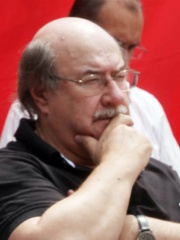
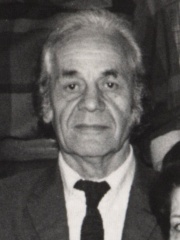
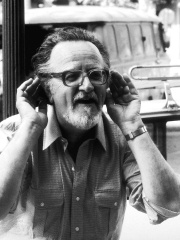
The Most Famous
WRITERS from Chile
This page contains a list of the greatest Chilean Writers. The pantheon dataset contains 7,302 Writers, 16 of which were born in Chile. This makes Chile the birth place of the 59th most number of Writers behind Albania, and South Korea.
Top 10
The following people are considered by Pantheon to be the top 10 most legendary Chilean Writers of all time. This list of famous Chilean Writers is sorted by HPI (Historical Popularity Index), a metric that aggregates information on a biography's online popularity. Visit the rankings page to view the entire list of Chilean Writers.

1. Pablo Neruda (1904 - 1973)
With an HPI of 82.29, Pablo Neruda is the most famous Chilean Writer. His biography has been translated into 127 different languages on wikipedia.
Pablo Neruda ( nə-ROO-də; Spanish: [ˈpaβlo neˈɾuða] ; born Ricardo Eliécer Neftalí Reyes Basoalto; 12 July 1904 – 23 September 1973) was a Chilean poet-diplomat and politician who won the 1971 Nobel Prize in Literature. Neruda became known as a poet when he was 13 years old and wrote in a variety of styles, including surrealist poems, historical epics, political manifestos, a prose autobiography, and passionate love poems such as the ones in his collection Twenty Love Poems and a Song of Despair (1924). Neruda occupied many diplomatic positions in various countries during his lifetime and served a term as a senator for the Chilean Communist Party. When President Gabriel González Videla outlawed communism in Chile in 1948, a warrant was issued for Neruda's arrest. Friends hid him for months, and in 1949 he escaped through a mountain pass near Maihue Lake into Argentina; he would not return to Chile for more than three years. He was a close advisor to Chile's socialist president Salvador Allende; Neruda served as Chile's ambassador to France under his presidency. When he went back to Chile after accepting his Nobel Prize in Stockholm, Allende invited him to read at the Estadio Nacional before 70,000 people. Neruda was hospitalized with cancer in September 1973, at the time of the coup d'état led by Augusto Pinochet that overthrew Allende's government, but returned home after a few days when he suspected a doctor of injecting him with an unknown substance for the purpose of murdering him on Pinochet's orders. Neruda died at his home in Isla Negra on 23 September 1973, just hours after leaving the hospital. Although it was long reported that he died of heart failure, the interior ministry of the Chilean government issued a statement in 2015 acknowledging a ministry document indicating the government's official position that "it was clearly possible and highly likely" that Neruda was killed as a result of "the intervention of third parties". However, an international forensic test conducted in 2013 rejected allegations that he was poisoned. Neruda is often considered the national poet of Chile, and his works have been popular and influential worldwide. The Colombian novelist Gabriel García Márquez once called him "the greatest poet of the 20th century in any language", and the critic Harold Bloom included Neruda as one of the writers central to the Western tradition in his book The Western Canon.

2. Gabriela Mistral (1889 - 1957)
With an HPI of 73.30, Gabriela Mistral is the 2nd most famous Chilean Writer. Her biography has been translated into 104 different languages.
Lucila Godoy Alcayaga (Latin American Spanish: [luˈsila ɣoˈðoj alkaˈʝaɣa]; 7 April 1889 – 10 January 1957), known by her pseudonym Gabriela Mistral (Spanish: [ɡaˈβɾjela misˈtɾal]), was a Chilean poet-diplomat, journalist and educator. She read widely in theosophy, became a member of the Secular Franciscan Order or Third Franciscan order in 1925, but rarely attended mass. She was the first Latin American author to receive a Nobel Prize in Literature in 1945, "for her lyric poetry which, inspired by powerful emotions, has made her name a symbol of the idealistic aspirations of the entire Latin American world". Some central themes in her poems are nature, betrayal, love, a mother's love, sorrow and recovery, travel, and Latin American identity as formed from a mixture of Native American and European influences. She also wrote an immense body of prose, about 800 articles that circulated throughout the Spanish-speaking world, on a range of topics: geography, education, profiles of her fellow writers, politics, and more. Her image is featured on the 5,000 Chilean peso banknote.

3. Alejandro Jodorowsky (b. 1929)
With an HPI of 73.28, Alejandro Jodorowsky is the 3rd most famous Chilean Writer. His biography has been translated into 47 different languages.
Alejandro Jodorowsky Prullansky (Spanish: [xoðoˈɾofski]; born 17 February 1929) is a Chilean and French avant-garde filmmaker. Known for his films El Topo (1970), The Holy Mountain (1973) and Santa Sangre (1989), Jodorowsky has been "venerated by cult cinema enthusiasts" for his work which "is filled with violently surreal images and a hybrid blend of mysticism and religious provocation". Dropping out of college, he became involved in theater and in particular mime, working as a clown before founding his own theater troupe, the Teatro Mimico, in 1947. Moving to Paris in the early 1950s, Jodorowsky studied traditional mime under Étienne Decroux, and put his miming skills to use in the silent film Les têtes interverties (1957), directed with Saul Gilbert and Ruth Michelly. From 1960 onwards he divided his time between Mexico City and Paris, where he co-founded Panic Movement, a surrealist performance art collective that staged violent and shocking theatrical events. In 1966 he created his first comic strip, Anibal 5, and in 1967 he directed his first feature film, the surrealist Fando y Lis, which caused a huge scandal in Mexico, eventually being banned. His next film, the acid western El Topo (1970), became a hit on the midnight movie circuit in the United States, considered the first-ever midnight cult film, and garnered high praise from John Lennon, who convinced former Beatles manager Allen Klein to provide Jodorowsky with $1 million to finance his next film. The result was The Holy Mountain (1973), a surrealist exploration of western esotericism. Disagreements with Klein, however, led to both The Holy Mountain and El Topo failing to gain widespread distribution, although both became classics on the underground film circuit. After a cancelled attempt at filming Frank Herbert's 1965 science fiction novel Dune, Jodorowsky produced five more films: the family film Tusk (1980); the surrealist horror Santa Sangre (1989); the failed blockbuster The Rainbow Thief (1990); and the first two films in a planned five-film autobiographical series The Dance of Reality (2013) and Endless Poetry (2016). Jodorowsky is also a comic book writer, most notably penning the science fiction series The Incal throughout the 1980s. Other comic books he has written include The Technopriests and Metabarons. Jodorowsky has also extensively written and lectured about his own spiritual system, which he calls "psychomagic" and "psychoshamanism", which borrows from alchemy, the tarot, Zen Buddhism and shamanism. His son Cristóbal has followed his teachings on psychoshamanism; this work is captured in the feature documentary Quantum Men, directed by Carlos Serrano Azcona.

4. Luis Sepúlveda (1949 - 2020)
With an HPI of 69.20, Luis Sepúlveda is the 4th most famous Chilean Writer. His biography has been translated into 40 different languages.
Luis Sepúlveda Calfucura (Spanish pronunciation: [ˈlwis seˈpulβeða kalfuˈkuɾa]; October 4, 1949 – April 16, 2020) was a Chilean writer and journalist. A communist militant and fervent opponent of Augusto Pinochet's regime, he was imprisoned and tortured by the military dictatorship during the 1970s. Sepúlveda authored numerous poetry books and short stories; in addition to Spanish, his mother tongue, he also spoke English, the language in which he wrote his first novel, El viejo que leía novelas de amor (The Old Man Who Read Love Stories).
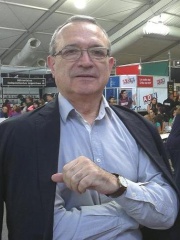
5. Sergio Badilla Castillo (b. 1947)
With an HPI of 67.95, Sergio Badilla Castillo is the 5th most famous Chilean Writer. His biography has been translated into 40 different languages.
Sergio Badilla Castillo (born November 30, 1947) is a Chilean poet who is the founder of poetic transrealism in contemporary poetry. He is considered the Latin American poet with the broadest Nordic influence, from the Finnish poets, Edith Södergran, Elmer Diktonius, Paavo Haavikko, Pentti Saarikoski and the Swedes Gunnar Ekelöf, Tomas Tranströmer and Lars Gustafsson.

6. Roberto Bolaño (1953 - 2003)
With an HPI of 67.50, Roberto Bolaño is the 6th most famous Chilean Writer. His biography has been translated into 46 different languages.
Roberto Bolaño Ávalos (Spanish: [roˈβeɾto βoˈlaɲo ˈaβalos] ; 28 April 1953 – 15 July 2003) was a Chilean novelist, short-story writer, poet and essayist. In 1999, Bolaño won the Rómulo Gallegos Prize for his novel The Savage Detectives, and in 2008 he was posthumously awarded the National Book Critics Circle Award for Fiction for his novel 2666, which was described by board member Marcela Valdes as a "work so rich and dazzling that it will surely draw readers and scholars for ages". Bolaño's work is highly regarded by both writers and contemporary literary critics. The New York Times described him as "the most significant Latin American literary voice of his generation" and he has frequently been compared with Jorge Luis Borges and Julio Cortázar. His books have been translated into numerous languages, including English, French, German, Italian, Lithuanian, Hungarian, Dutch and Greek.

7. Antonio Skármeta (1940 - 2024)
With an HPI of 64.13, Antonio Skármeta is the 7th most famous Chilean Writer. His biography has been translated into 27 different languages.
Esteban Antonio Skármeta Vranicic (November 7, 1940 – October 15, 2024) was a Chilean writer, screenwriter, and director. His novel Ardiente paciencia was the basis for the film Il Postino. In Chile, he was popularly known for hosting a television show on literature and the arts. He served as Chile’s ambassador to Germany from 2000 to 2003. In 2014, he was awarded the Chilean National Literature Prize.

8. Nicanor Parra (1914 - 2018)
With an HPI of 63.41, Nicanor Parra is the 8th most famous Chilean Writer. His biography has been translated into 39 different languages.
Nicanor Segundo Parra Sandoval (5 September 1914 – 23 January 2018) was a Chilean physicist and poet. He has been considered one of the most influential Spanish-language Chilean poets of the 20th century. Parra described himself as an "anti-poet" on account of his distaste for poetry's pompous pretences. After his recitations, he would say: "Me retracto de todo lo dicho." ("I take back everything I've said.")

9. José Donoso (1924 - 1996)
With an HPI of 60.87, José Donoso is the 9th most famous Chilean Writer. His biography has been translated into 24 different languages.
José Manuel Donoso Yáñez (5 October 1924 – 7 December 1996), known as José Donoso, was a Chilean writer, journalist and professor. He lived most of his life in Chile, although he spent many years in self-imposed exile in Mexico, the United States and Spain. Although he stated that he had left Chile in the 1960s for personal reasons, after 1973 his exile was also a form of protest against the dictatorship of Augusto Pinochet. He returned to Chile in 1981 and lived there until his death in 1996. Donoso is the author of a number of short stories and novels, which contributed greatly to the Latin American literary boom. His best known works include the novels Coronation, Hell Has No Limits (El lugar sin límites), and The Obscene Bird of Night (El obsceno pájaro de la noche). His works are known for their dark sense of humor and themes including sexuality, the duplicity of identity, and psychology.
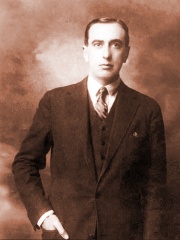
10. Vicente Huidobro (1893 - 1948)
With an HPI of 59.90, Vicente Huidobro is the 10th most famous Chilean Writer. His biography has been translated into 28 different languages.
Vicente García-Huidobro Fernández (Latin American Spanish: [biˈsente ɣwiˈðoβɾo]; January 10, 1893 – January 2, 1948), known by the pseudonym Vicente Huidobro, was a Chilean poet, writer, editor and literary critic. A proponent of the avant-garde, Huidobro was the founder of Creationism (Spanish: creacionismo) and is considered one of the four greats of Chilean poetry.
People
Pantheon has 16 people classified as Chilean writers born between 1889 and 1987. Of these 16, 3 (18.75%) of them are still alive today. The most famous living Chilean writers include Alejandro Jodorowsky, Sergio Badilla Castillo, and Snooki. The most famous deceased Chilean writers include Pablo Neruda, Gabriela Mistral, and Luis Sepúlveda.
Living Chilean Writers
Go to all RankingsAlejandro Jodorowsky
1929 - Present
HPI: 73.28
Sergio Badilla Castillo
1947 - Present
HPI: 67.95
Snooki
1987 - Present
HPI: 50.43
Deceased Chilean Writers
Go to all RankingsPablo Neruda
1904 - 1973
HPI: 82.29
Gabriela Mistral
1889 - 1957
HPI: 73.30
Luis Sepúlveda
1949 - 2020
HPI: 69.20
Roberto Bolaño
1953 - 2003
HPI: 67.50
Antonio Skármeta
1940 - 2024
HPI: 64.13
Nicanor Parra
1914 - 2018
HPI: 63.41
José Donoso
1924 - 1996
HPI: 60.87
Vicente Huidobro
1893 - 1948
HPI: 59.90
Cristina Calderón
1928 - 2022
HPI: 59.81
Alberto Hurtado
1901 - 1952
HPI: 58.91
Francisco Coloane
1910 - 2002
HPI: 58.65
Jorge Edwards
1931 - 2023
HPI: 57.46
Overlapping Lives
Which Writers were alive at the same time? This visualization shows the lifespans of the 13 most globally memorable Writers since 1700.

